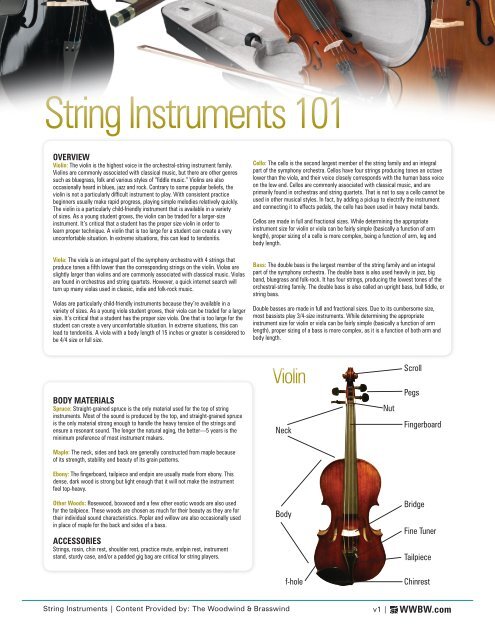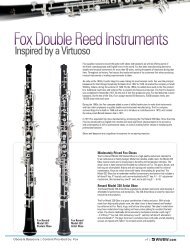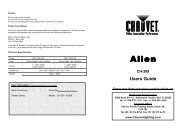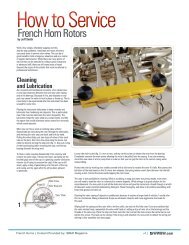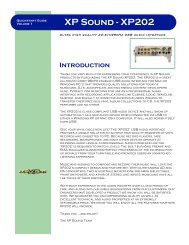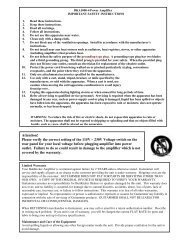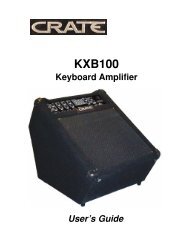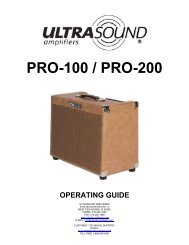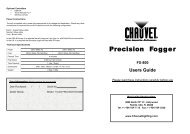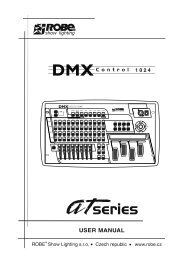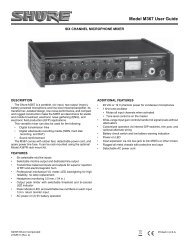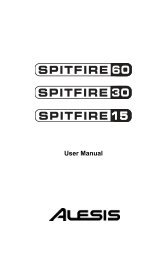String Instruments 101
String Instruments 101
String Instruments 101
Create successful ePaper yourself
Turn your PDF publications into a flip-book with our unique Google optimized e-Paper software.
<strong>String</strong> <strong>Instruments</strong> <strong>101</strong><br />
OVERVIEW<br />
Violin: The violin is the highest voice in the orchestral-string instrument family.<br />
Violins are commonly associated with classical music, but there are other genres<br />
such as bluegrass, folk and various styles of “fi ddle music.” Violins are also<br />
occasionally heard in blues, jazz and rock. Contrary to some popular beliefs, the<br />
violin is not a particularly diffi cult instrument to play. With consistent practice<br />
beginners usually make rapid progress, playing simple melodies relatively quickly.<br />
The violin is a particularly child-friendly instrument that is available in a variety<br />
of sizes. As a young student grows, the violin can be traded for a larger-size<br />
instrument. It’s critical that a student has the proper size violin in order to<br />
learn proper technique. A violin that is too large for a student can create a very<br />
uncomfortable situation. In extreme situations, this can lead to tendonitis.<br />
Viola: The viola is an integral part of the symphony orchestra with 4 strings that<br />
produce tones a fi fth lower than the corresponding strings on the violin. Violas are<br />
slightly larger than violins and are commonly associated with classical music. Violas<br />
are found in orchestras and string quartets. However, a quick internet search will<br />
turn up many violas used in classic, indie and folk-rock music.<br />
Violas are particularly child-friendly instruments because they’re available in a<br />
variety of sizes. As a young viola student grows, their viola can be traded for a larger<br />
size. It’s critical that a student has the proper size viola. One that is too large for the<br />
student can create a very uncomfortable situation. In extreme situations, this can<br />
lead to tendonitis. A viola with a body length of 15 inches or greater is considered to<br />
be 4/4 size or full size.<br />
BODY MATERIALS<br />
Spruce: Straight-grained spruce is the only material used for the top of string<br />
instruments. Most of the sound is produced by the top, and straight-grained spruce<br />
is the only material strong enough to handle the heavy tension of the strings and<br />
ensure a resonant sound. The longer the natural aging, the better—5 years is the<br />
minimum preference of most instrument makers.<br />
Maple: The neck, sides and back are generally constructed from maple because<br />
of its strength, stability and beauty of its grain patterns.<br />
Ebony: The fi ngerboard, tailpiece and endpin are usually made from ebony. This<br />
dense, dark wood is strong but light enough that it will not make the instrument<br />
feel top-heavy.<br />
Other Woods: Rosewood, boxwood and a few other exotic woods are also used<br />
for the tailpiece. These woods are chosen as much for their beauty as they are for<br />
their individual sound characteristics. Poplar and willow are also occasionally used<br />
in place of maple for the back and sides of a bass.<br />
ACCESSORIES<br />
<strong>String</strong>s, rosin, chin rest, shoulder rest, practice mute, endpin rest, instrument<br />
stand, sturdy case, and/or a padded gig bag are critical for string players.<br />
<strong>String</strong> <strong>Instruments</strong> | Content Provided by: The Woodwind & Brasswind<br />
Cello: The cello is the second largest member of the string family and an integral<br />
part of the symphony orchestra. Cellos have four strings producing tones an octave<br />
lower than the viola, and their voice closely corresponds with the human bass voice<br />
on the low end. Cellos are commonly associated with classical music, and are<br />
primarily found in orchestras and string quartets. That is not to say a cello cannot be<br />
used in other musical styles. In fact, by adding a pickup to electrify the instrument<br />
and connecting it to effects pedals, the cello has been used in heavy metal bands.<br />
Cellos are made in full and fractional sizes. While determining the appropriate<br />
instrument size for violin or viola can be fairly simple (basically a function of arm<br />
length), proper sizing of a cello is more complex, being a function of arm, leg and<br />
body length.<br />
Bass: The double bass is the largest member of the string family and an integral<br />
part of the symphony orchestra. The double bass is also used heavily in jazz, big<br />
band, bluegrass and folk-rock. It has four strings, producing the lowest tones of the<br />
orchestral-string family. The double bass is also called an upright bass, bull fi ddle, or<br />
string bass.<br />
Double basses are made in full and fractional sizes. Due to its cumbersome size,<br />
most bassists play 3/4-size instruments. While determining the appropriate<br />
instrument size for violin or viola can be fairly simple (basically a function of arm<br />
length), proper sizing of a bass is more complex, as it is a function of both arm and<br />
body length.<br />
Violin<br />
Neck<br />
Body<br />
f-hole<br />
Nut<br />
Scroll<br />
Pegs<br />
Fingerboard<br />
Bridge<br />
Fine Tuner<br />
Tailpiece<br />
Chinrest<br />
v1 | WWBW.com
<strong>String</strong> <strong>Instruments</strong> <strong>101</strong><br />
ANATOMY<br />
Scroll: A decorative piece at the top of the instrument.<br />
Pegs: Typically constructed from a very dense wood. Pegs are used to adjust the<br />
tension on the strings, resulting in tuning.<br />
Machine Heads or Tuning Machines: Typically made from brass or nickel.<br />
Machine heads are geared and used to adjust the tension and tune the strings<br />
on the upright double bass.<br />
Peg Box: A box between the scroll and nut that secures the pegs and/or the<br />
machine heads.<br />
Neck: Typically constructed from quality hard maple. A lot of stress is placed on<br />
the stringed instrument neck. When brought to proper pitch, there can be over<br />
200 pounds of tension on double bass neck.<br />
Fingerboard: A long piece of wood glued on the top of the neck. This stiff, dense<br />
wood adds strength to the neck to prevent it from warping. Quality fi ngerboards<br />
are scooped inward towards the center and made from ebony.<br />
Bridge: The bridge is held in place only by tension; no glue is used. Quality<br />
bridges are hand-fi tted against the body to ensure proper sound transmission.<br />
The bridge is higher where the lowest string crosses. Some bridges are heightadjustable,<br />
which makes raising or lowering string action quick and easy.<br />
Nut: A small raised piece of ebony at the top of the fi ngerboard with grooves for<br />
the strings that keeps the strings properly spaced, and raises them the proper<br />
distance from the fi ngerboard at the top end of the instrument.<br />
Cello<br />
Body<br />
Neck<br />
f-hole<br />
Scroll<br />
Pegs<br />
Fingerboard<br />
Bridge<br />
Fine Tuner<br />
Tailpiece<br />
Endpin<br />
<strong>String</strong> <strong>Instruments</strong> | Content Provided by: The Woodwind & Brasswind<br />
Nut<br />
Continued<br />
Viola<br />
Neck<br />
Body<br />
f-hole<br />
Nut<br />
Scroll<br />
Pegs<br />
Fingerboard<br />
Bridge<br />
Fine Tuner<br />
Tailpiece<br />
Chinrest<br />
F-Hole: Two holes precisely cut in the top to permit it to respond more freely,<br />
and sound to be projected from the interior of the instrument.<br />
Tail Piece: Found near the bottom of the instrument, the tailpiece anchors the<br />
bottom of each string. It can be made of a variety of strong dense materials,<br />
including ebony, carbon fi ber composite, plastic compounds, or light metals,<br />
such as aluminum. Add-on devices for fi ne tuning of strings are sometimes<br />
attached to a tailpiece. Fine tuners are also built into the tailpiece on<br />
some models.<br />
Tail Gut (tail piece gut, tail piece adjuster): A cord / cable / wire, originally<br />
made from animal intestine, now constructed from nylon or metal, which<br />
transfers the tension from the strings to the endpin or button, across the saddle.<br />
Fine Tuner: A small mechanical add on device generally attached to the<br />
tailpiece that permits very precise adjustments in string tension for tuning to<br />
pitch. Fine tuners are extremely helpful in tuning steel strings where a very<br />
small change in tension produces a relatively large change in pitch. They are<br />
of limited effectiveness on gut or synthetic core strings due to the inherent<br />
“stretch” of the core material which requires a fairly large increase in tension to<br />
produce any appreciable change in pitch.<br />
Endpin: A retractable/extendable rod, held in playing position by a thumbscrew,<br />
which projects from the bottom of a cello or bass. It provides height<br />
adjustment for various size players, and also serves as a anchoring point for the<br />
tailgut.<br />
Button: On a violin or viola, a small wooden knob fi tted tightly into the bottom<br />
end of the instrument which anchors the tail gut.<br />
Sound Post: Located on the inside of the body, the sound post is held in place<br />
between the top and the back of the instrument by by provides structural<br />
support and transmits sound from the top to the back.<br />
Bass Bar: On the inside of the body, a small piece of wood that is glued under<br />
the lowest string. The bass bar strengthens structural support and distributes<br />
the sound over the entire length of the top of the instrument.<br />
Chin Rest: A misnomer because the jaw should actually rest against the<br />
chinrest, and the chin should be near the tail piece for a proper fi t. Chinrests<br />
are available in a variety of shapes, heights and sizes for a personalized level<br />
of comfort.<br />
v1 | WWBW.com
Body<br />
Bass<br />
Neck<br />
f-hole<br />
<strong>String</strong><br />
Instrument<br />
Sizing Charts<br />
Scroll<br />
Machine Head<br />
Nut<br />
Fingerboard<br />
Bridge<br />
Fine Tuner<br />
Tailpiece<br />
Endpin<br />
Violin Size Arm Length<br />
4/4 (full size) 23"<br />
3/4 22"<br />
1/2 20"<br />
1/4 18 1/2"<br />
1/8 16 1/2"<br />
1/10 15"<br />
1/16 14"<br />
Viola Size Arm Length<br />
16 1/2" 26 1/2"+<br />
16" 26"<br />
15 1/2" 25 1/4"<br />
15" 24 1/2"<br />
14" 23"<br />
13" 21 1/4"<br />
12 1/4" 20"<br />
<strong>String</strong> <strong>Instruments</strong> | Content Provided by: The Woodwind & Brasswind<br />
<strong>String</strong> <strong>Instruments</strong> <strong>101</strong><br />
CONSTRUCTION<br />
Handcrafted: Building a string instrument is as much art as it is science.<br />
Workshops employ luthiers, or stringed instrument makers, at different levels of<br />
experience. The least experienced crafters typically work on less-expensive student<br />
instruments. As the luthiers’ skill and experience increases, so does the level of<br />
instrument they craft.<br />
Set-Up: “Fine tuning” and adjusting the instrument’s individual components<br />
to produce the optimal sound and ease of play. This can be done by the<br />
constructing luthier, or quite of manufacturer’s employ “set-up” technicians to<br />
prepare the instrument to play at its highest potential. Detailed shaping and shaving<br />
of components, fi tting the bridge, adjusting proper depth and shape of the notches<br />
at the bridge and the nut, and fi ne tuning are all responsibilities of the<br />
“set-up” technician.<br />
Flamed Maple: Flaming is a visual property of some woods, most noticeably<br />
maple, that gives a wavy 3-dimensional appearance to the fi nished wood. It can<br />
be enhanced by a variety of stains and other treatments. While this enhances the<br />
visual appeal of a stringed instrument it does not necessarily enhance the quality<br />
of sound produced.<br />
Book-Matched: Most instrument backs are “book-matched,” or constructed from<br />
two pieces of wood glued together. This process gives the instrument a uniform<br />
appearance, but does not necessarily improve the sound quality.<br />
Lamination: Basses may have a laminated top, basically a thin piece of plywood.<br />
This process strengthens and stabilizes the instruments.<br />
STRING SELECTION<br />
The single most infl uential factor (after skill) of sound quality produced by a<br />
stringed instrument is the choice of strings. There is no absolutely correct type of<br />
string for all players under all circumstances. Each type of string has qualities that<br />
make it more appropriate for different situations (i.e. solo vs. orchestral or country<br />
vs. classical performances). Other factors such as cost, the players’ individual<br />
preferences, and the way a particular string sounds on an individual instrument also<br />
come into play.<br />
Violin / Viola Sizing Cello Sizing Bass Sizing<br />
With arm extended level with the<br />
shoulder and palm up, measure from<br />
the neck to the center of the palm.<br />
A<br />
Full Size (4/4) With the knees separated<br />
14" – 15"(A), the distance from inside<br />
of right knee to middle of left ear (B)<br />
should be 30+ inches.<br />
3/4 Size With the knees separated<br />
about 13 1⁄2" – 14"(A), the distance<br />
from inside of right knee to middle of left<br />
ear (B) should be about 27 1⁄2" – 30".<br />
1/2 Size With the knees separated<br />
about 12" – 13"(A), the distance from<br />
inside of right knee to middle of left ear<br />
(B) should be about 25 1⁄2" – 27 1⁄2".<br />
Visit WWBW.com for additional<br />
orchestral string sizing information!<br />
B<br />
Bass Size Hand / Eye<br />
Distance<br />
4/4 (rare) 41"+<br />
3/4 (usual<br />
full size)<br />
Continued<br />
Approximate “ideal measurement” for<br />
the various bass sizes is as follows:<br />
39"<br />
1/2 35 7/8"<br />
1/4 33 1/4"<br />
v1 | WWBW.com


